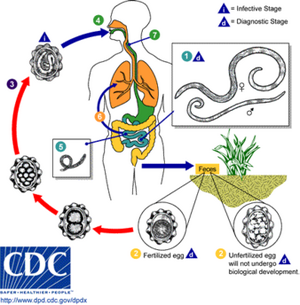Ascariasis 1.Lf
Ascariasis is a parasitic disease caused by the roundworm (Ascaris lumbricoides). This is endemic nematodosis ( a disease caused by nematodes). The disease is cosmopolitan and prevention is closely related to hygiene. The prevalence in Europe is low, while it is high in Central and South-East Asia, Central and South America. The mortality rate of the disease is 60–100,000/year. The disease is spread orofecally by nematode eggs, causing intestinal disorders and diarrhea. It has two
phases:
- the first – lung phase: it passes through the blood to the lungs, after coughing and swallowing it goes back to the intestine – inflammatory and immune reactions prevail
- the second – intestinal phase: roundworms live mainly in the jejunum, where they cause problems in the gastrointestinal tract
Progression of the disease[edit | edit source]
An adult is around 10 cm and is most often found in the small intestine, where it takes nutrients from a person. This manifests as indigestion and malnutrition, which can cause stunted growth in children. The roundworm produces toxins, waste materials and substances that create an ideal environment for growth and development. These substances cause allergic reactions, fever and can also cause epilepsy.
In addition, roundworms cause mechanical damage to the intestinal mucosa, which can result in inflammatory reactions in the intestinal wall. This manifests itself as shortening and widening of the villi, lengthening of the crypts, thickening of the mucous membrane. Adults can migrate against peristalsis and can invade the bile ducts, stomach, pancreas, and oral cavity. This movement can result in inflammatory changes, obstruction of the bile ducts and introduction of bacterial infection. During surgery, roundworms can migrate and cause problems in other organs.
The Clinical Presentation[edit | edit source]
The most common symptoms:
Clustering of roundworms during massive infestations can result in::
- ischemia,
- obstructive jaundice,
- appendicitis,
- obstructive ileus,
- secondary bacterial infection,
Diagnosis[edit | edit source]
Extraintestinal form: Larvae can be caught in sputum, which we examine microscopically. 5-6 day, the sputum is bloody and contains eosinophils. Part of the pulmonary symptoms is the so-called Löffler's syndrome - the formation of eosinophilic granulomas in the lungs.
Intestinal form: Microscopic examination of stool in which we can find eggs.
Therapy[edit | edit source]
- Basic drug – mebendazole (Vermox®) – 100 mg 2 times a day between meals for 3 days,
- Others – albendazole, piperazine, levamisole, thiabendazole.
Links[edit | edit source]
Resources[edit | edit source]
- BENEŠ, Jiří. Studijní materiály [online]. ©2007. [cit. 2009]. <http://www.jirben.wz.cz/>.
- RNDR. MGR. CHANOVÁ, PH.D, Marta. Nákazy vyvolané hlísticemi [přednáška k předmětu Parazitilogie, obor Všeobecné lékařství, 1. LF Univerzita Karlova]. Praha. 12. 10. 2015.
Reference[edit | edit source]
- BENEŠ, Jiří, et al. Infekční lékařství. 1. vydání. Galén, 2009. 651 s. s. 350, 351. ISBN 978-80-7262-644-1
Recommended literature[edit | edit source]
- BEDNÁŘ, Marek, Andrej SOUČEK a Věra FRAŇKOVÁ, et al. Lékařská mikrobiologie : Bakteriologie, virologie, parazitologie. 1. vydání. Praha : Marvil, 1996. 558 s. ISBN 8594031505280.


